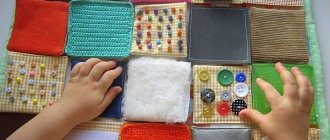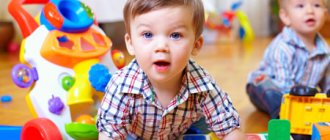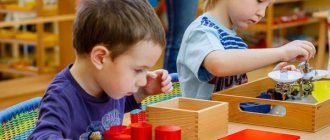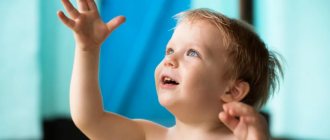By the baby's first birthday, a lot of achievements accumulate, but the most interesting things begin later. The development of a child from one year to the next is a whole adventure: the baby moves around with all his might, grabs everything he can reach and literally becomes smarter every day.
In classes using the Montessori method for children from one year old, they try to take into account all aspects of development in this period, but it is not enough to simply use a random set of exercises, it is important to balance different types of activity and ensure that the overall environment for the baby is conducive to his development. We have prepared a whole webinar on this topic, you can watch it below:
Montessori system: methods principles
Principle No. 1. Guide the child’s self-development. To do this, it is necessary to organize special conditions. In them he himself will look for answers to questions. The teacher’s task is to reveal the child’s potential.
Principle No. 2. Individual approach. Each child - in a kindergarten, school or family group - is treated individually. They take into account his personal characteristics, temperament, abilities, interests.
Principle No. 3. Recognize the uniqueness of the child. It was given to him from birth. And by nature, a child has a desire to work, develop, and improve himself. The main thing is to push him.
Principle No. 4. Unleash potential, not “sculpt” character. Parents and teachers are “guides”, not an unshakable authority. They do not teach and educate, but guide children and encourage them to act independently.
Principle #5 : Learning through discovery. The children learn new things and master skills through working with didactic material and toys. Learning by doing, not by what the teacher tells you.
Some parents confuse the principle of non-interference with passivity. It is not right. Montessori education requires special training. But parents can implement it at home too.
Find a cap by size (from 2 to 4 years)
Objectives of the exercise : development of visual and motor coordination.
You will need: 4-6 bottles or jars of different sizes with lids (the lids can be stored in a small container).
Presentation : place bottles on the table in front of the child; slowly remove the caps and screw them back on; First, put on the caps that match the size of the bottles, then mix the caps and let the child choose the right caps for the bottles.
Montessori environment for children's development
The Montessori education system will be effective if a number of rules are followed. One of them is the organization of space for classes. It should be spacious, bright, cozy and quiet. Furniture should correspond to the height of children - for free access to materials and toys.
An important role is played by the zoning of the premises - there are 5 zones:
- Sensory. Here they develop their sense of smell, touch, hearing and vision. Children learn to distinguish and combine objects according to different characteristics;
- Mathematical. Here they develop logical thinking and learn how to perform mathematical operations. The children master the concept of quantity and its connection with symbols;
- Language. Here the children learn to read and write;
- "Space". Natural phenomena, the surrounding world, culture, history - the children will learn about all this in this zone;
- Practical. Here children learn self-service and self-care skills.
The guys decide for themselves which zone they want to be in at the moment. The duration of classes, the material, the pace of learning - they choose it all themselves. The adult’s task is to stimulate interest in the lesson and guide the student.
Wooden children's toys according to the Montessori system
In 90% of the class time, children learn from materials - educational toys, household items. Their difference from other toys is natural materials: wood, fur, fabrics of different textures.
Laces, fasteners, insert frames, cubes, pyramids, magnetic fishing, musical instruments, puzzles, sorters, boards with cylinders, games for training fine motor skills - the variety of wooden children's toys according to the Montessori system is enormous. They are arranged according to the thematic zone.
Benefits play an important role - learning takes place in the form of a game. This is the leading type of activity for the guys, they are interested - the effectiveness of the classes increases.
Benefits of the Montessori method for children
Early development has many benefits. Let's list them:
- the boys learn responsibility. In the future, they themselves identify and correct errors;
- kids are independent. From an early age they learn self-service skills - dressing, washing, brushing teeth, cleaning up after themselves;
- organize their time - leisure, study, play themselves. In the future, time is controlled;
- successfully socialize - adapt to any team, accept and follow the rules. Adopt and pass on the experience gained, help others;
- develop initiative - strive to learn, are interested in new things, ask questions, look for answers and solutions.
The goal of Maria Montessori's education system is the formation of a free, holistic personality. A free person knows his own boundaries and respects the boundaries of other people.
Rules of communication using the Montessori method for children
They will be useful to children in adulthood.
- Don't disturb if the person is busy;
- Help the younger one;
- Consider the interests of others when choosing an area to play or study;
- Be quiet - don't disturb other guys;
- Take away your toys and manuals, wipe the surface after modeling or drawing;
- The toy is busy - wait your turn.
Box with fabric samples (from 2.5 to 5 years)
Objectives of the exercise : development and refinement of tactile sensations.
You will need: a small box containing a couple of pieces of each fabric of different textures (for example, silk, cotton, wool, mohair, etc.).
Presentation:
- show your baby three pairs of pieces of fabric that contrast the most in texture;
- then mix them and ask the child to find the pairs by feeling them with his hands;
- when the baby understands the meaning of the exercise, add other pieces of fabric;
- encourage your child to do the same thing blindfolded.
Sensitive periods in the Montessori education system
Sensitivity is sensitivity, receptivity. At each age period, the child is susceptible to a certain type of activity. The timing and duration of the sensitive period is different for everyone, age also varies - children develop differently. Psychologists advise parents to focus on their own child.
In the Montessori method for children, sensitive periods play an important role.
From birth to 6 years: speech development
At the age of up to 12 months, children are passionate about speech and communication with their parents. This happens through onomatopoeia, the emotional sphere. Kids crave interaction with adults. Speech is not available to them - emotional contact with loved ones comes to the fore. A lack of attention and communication will lead to disruption of the further full development of the child.
From 1 to 3 years is the period of mastering oral speech. A lack of verbal communication at this age has catastrophic consequences - the child will never be able to speak normally. Never in life is vocabulary enriched as intensively as during this period.
Adherents of the Montessori method of education advise speaking with your daughter or son during this period competently, like an adult. Don’t shorten your words, don’t lisp, watch your diction—the children follow your example.
From 3 to 6 years old is the period of learning to read and write. Younger children are interested in letters. They try to write a letter or put it together from available materials - sticks, beans, plasticine. By the age of 5, they are interested in learning to read - this is the most successful period for learning, use it. Moreover, first teach your child to write, and then to read - this way the process will be faster and easier.
Ages up to 3 years: sensitivity to order
For children's peace of mind, order is important: in things, toys, clothes, and a stable daily routine. Try not to change it unnecessarily - this may upset the balance. At 2 - 2.5 years old, babies can be capricious and mischievous. The reason may lie in the disorder.
Stable behavior of family members is very important. Act according to the established rules: neither your mood nor problems should change your attitudes. This affects the emotional state of your child.
Age up to 5.5 years: sensory development
Children train their vision, hearing, and senses in a natural way. You can enhance the effect with exercise. For example, invite your child to close his eyes and evaluate the size, taste, and aroma of the object.
Diversify your child’s sensory experiences: go to theaters and concerts. At home, listen to music and study the sound of everyday objects - hit a glass, a saucepan, a wooden table with a spoon - compare the sounds. Play with children's musical instruments - xylophone, drum, tambourine, maracas.
From 1.5 to 5.5 years: development of fine motor skills
The period is exciting and dangerous. Parents must be on alert. Kids love to finger small objects—buttons, peas, beads—in their fingers and put them in their ear, nose, and mouth. Such games are useful, but must be supervised by adults.
The development of fine motor skills affects the further development of speech: the better the baby’s fingers, the better he speaks. Neuropsychologists say: a baby’s speech is at his fingertips. Supporters of the Montessori method of education advise collecting a collection of mini-objects - encourage the child to play with them.
Age up to 4 years: physical development
Period of physical activity: the children begin to walk, run, and climb high slides. This helps strengthen muscles, improve coordination, oxygenate brain cells - and mental development. Kids should spend at least 1 hour a day active - running, jumping, climbing.
Movement coordination training helps children better control their bodies and master new actions. Don’t suppress your child’s impulses: he wants to climb the stairs - let him! Help him, teach him - these are important skills.
Ages from 2.5 to 6 years: socialization
First, kids learn polite words - “hello”, thank you.” And with age they master etiquette. During this period, the foundations of behavior in society are laid. Set an example of polite communication for your child - he will absorb everything like a sponge.
Matching games
Matching games are the most popular Montessori activities for ages 1 to 3. The main types are:
- Activities with colors - you can offer your child a cardboard circle with multi-colored sectors and clothespins of the same shades. The child must independently choose his own clothespin for each sector.
- The game can be combined with the help of mom. For example, invite your child to sort washed socks into pairs.
Patriotic education of preschool children
This group of classes develops logic and attention.
Games with colors
Introducing the Montessori method at home
Do you want to develop your child from an early age according to the system of an Italian teacher? Start with family. The relationship between mom and dad, grandparents and the child plays an important role in its development. The family is an extension of the Montessori environment. Therefore, you must create the same developmental environment at home.
Organize your space . It must meet the child's needs. When equipping a nursery using the Montessori system, pay attention to these points:
- interior - harmonious, pastel colors, zoning;
- The furniture is wooden, low, taking into account the height of the child. A low bed without railings or a high mattress, a table and chair according to his height, low shelves for toys - the daughter, the son himself should easily take them and put them in place. Change the range of toys periodically;
- mat - for active games on the floor;
- tools for creativity - modeling dough, finger paints, album;
- cleaning tools - for the little ones a cloth is enough, for older children - a dustpan and a brush for cleaning after games and activities.
Psychologists recommend teaching children to eat with their parents in the kitchen or dining room. According to the Montessori method, at home it would not hurt to organize a place for snacks in the baby’s room. For example, putting a carafe of water or a bowl of fruit - teachers don’t see anything wrong with this.
To accustom your child to a sense of beauty, place flowers in the room. As they grow older, entrust your son or daughter with caring for the flower: wiping off dust, watering.
Choose items based on age. This applies to toys, dishes, clothes, furniture. For example, according to the Montessori method of education, leave 2-3 sets of clothes in the access area - let the child choose what he wants to wear today.
Don't put pressure on the child. Respect his interests and desires. The baby is interested - he will play and study on his own without reminders or coercion.
Sprinkling rice (from 2.5 to 5 years)
Objectives of the exercise : developing muscular coordination, the ability to carefully pour from a jug into a cup, gaining confidence in one’s abilities.
You will need: a small tray with a glass and a jug half filled with rice; cloth for wiping the table.
Presentation : show all the objects on the table and name them and actions with them (“glass”, “jug”, “pour”, etc.); Take the jug by the handle with one hand and the glass with the other; Place the jug exactly in the middle above the glass and pour rice into it; Now let the child work on his own. When the baby reaches perfection in pouring rice, you can move on to liquid substances, allowing the child to pour milk or juice from a jug into a glass.
Disadvantages of the Montessori method for children
The method is used in modern early development centers and private kindergartens. It has many advantages, but is not without its disadvantages.
Gaming activity does not matter . The author of the method believed that games are far from reality and are not needed by children. She was wrong: play activity is the leading activity for children. They are provided with a wide selection of educational games, but they are aimed more at developing mental abilities.
Communication skills are not fully developed . Children study individually and develop independence. This does not contribute to the development of sociability. Although the older guys help the younger ones, the system helps socialization.
The pedagogical significance of fairy tales is ignored . Instead, use a concise description of the items. But fairy tales form in children an idea of good and evil, good and bad, and life in general.
No authority . The teacher does not take on the role of authority. Children come to school with an unformed attitude towards the teacher as an authority. But schools do not operate according to the Montessori system. A young student may have problems.
They don't prepare kids for school. First, they don't put much effort into learning or learning new things. Therefore, they are not accustomed to working hard to get results. Secondly, there is no strict discipline, as in a regular school. Therefore, young students may have problems complying and adapting to school.
Who is not suitable for the Montessori education system?
Parents take their children to Montessori kindergartens and practice this system at home. But is such a desire justified? There are 2 opinions on this matter.
First, the technique is suitable for all children, but not for all parents. For example, authoritarian mothers and fathers will not give the baby much freedom. Did you recognize yourself in history? Reconsider your attitude towards upbringing and interaction with your child: authoritarianism suppresses the little person. It’s easier for you to adjust than for a child.
The second opinion is that the Montessori system is not suitable for all children. And so it is. Consider alternative development options if your child:
- Creative person. Does the child have a developed imagination, does he invent stories, fantasize? He will be bored in class. Try practicing the Montessori method at home: alternate games, combine them, come up with your own variations;
- Uncommunicative. A closed, insecure child can withdraw into himself even more. After all, according to the Montessori method, children study independently, which does not contribute to the development of sociability. And the little introvert will become a beech;
- Restless and restless. Restless, active and restless kids may not fit into the measured, quiet atmosphere of the class. Your fidget will not be able to follow the rule of not disturbing others. Try implementing the Montessori method at home. It will be easier for you to catch the moment when your child is ready to exercise;
- Diagnosed with ASD and autism. Exercise with caution. During classes, isolation and detachment may increase. But practicing the Montessori method at home will be useful: games and exercises require perseverance, which such kids cannot lack;
- Sensitive period missed. Is this your case? Be prepared for the futility of Montessori education. You can try. Pay attention to the personality of the teacher: he should be passive, coordinate the child’s work and not interfere in the process.
Creative corner
Very often, paints, plasticine, and glue are stored in drawers and other places inaccessible to children. A child draws only when his mother suggests, and not when he wants it. However, it is very important to provide the child with the opportunity for spontaneous creativity.
Try to organize a creative corner for your child so that the same rules about accessibility, limited availability and regular updating of materials are observed.
This could be a creative table in a place convenient for the child or a shelf on your shelf reserved for creative materials. Do not post a lot of different materials there at once; it would be better if they are updated regularly.
Naturally, if the child is still too young, tastes almost everything and does not yet know the rules for working with certain materials, you should not put glue, sharp scissors or liquid paints in the public domain. But you can already put a stack of paper and a few wax crayons.










